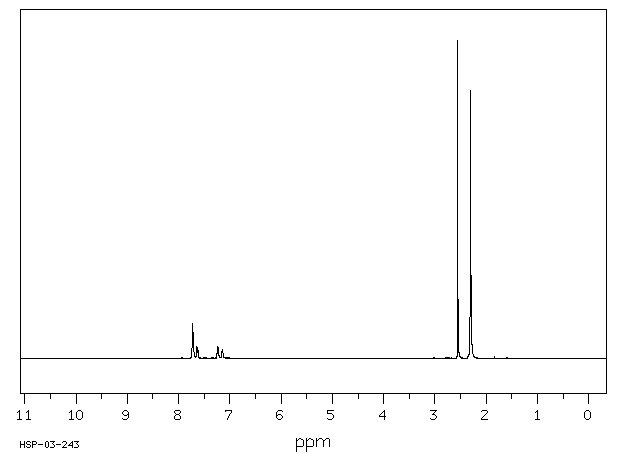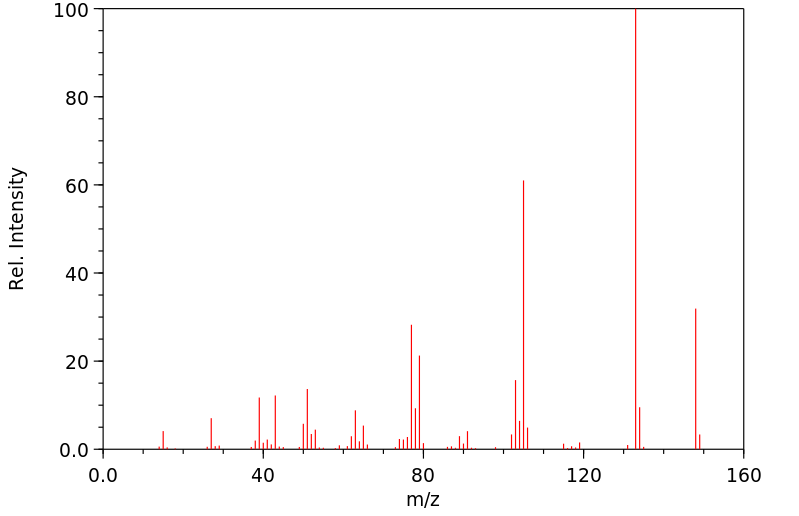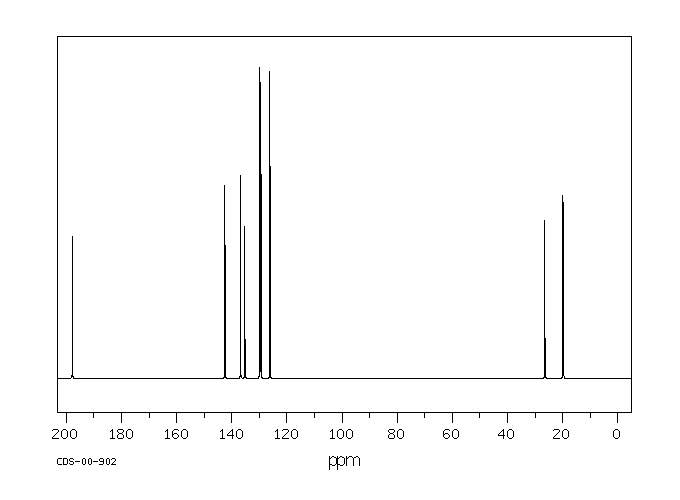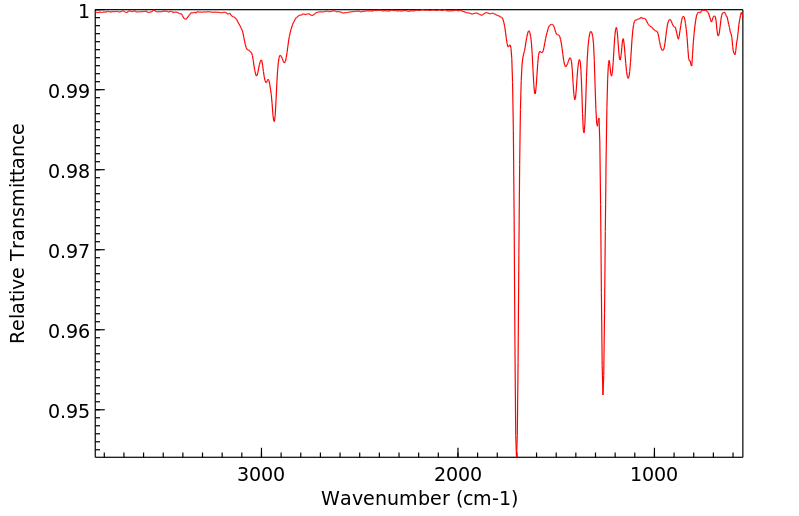3,4-二甲基苯乙酮 | 3637-01-2
中文名称
3,4-二甲基苯乙酮
中文别名
1-(3,4-二甲基苯基)乙-1-酮;3',4'-二甲基苯乙酮
英文名称
3,4-dimethylacetophenone
英文别名
1-(3,4-dimethylphenyl)ethanone;1-(3,4-dimethylphenyl)ethan-1-one;3',4'-Dimethylacetophenone
CAS
3637-01-2
化学式
C10H12O
mdl
MFCD00008743
分子量
148.205
InChiKey
WPRAXAOJIODQJR-UHFFFAOYSA-N
BEILSTEIN
——
EINECS
——
-
物化性质
-
计算性质
-
ADMET
-
安全信息
-
SDS
-
制备方法与用途
-
上下游信息
-
文献信息
-
表征谱图
-
同类化合物
-
相关功能分类
-
相关结构分类
物化性质
-
熔点:-1.5°C
-
沸点:243 °C(lit.)
-
密度:1.001 g/mL at 25 °C(lit.)
-
闪点:217 °F
-
LogP:2.590 (est)
-
物理描述:Liquid
-
保留指数:1828;1836;1831;1831;1823
-
稳定性/保质期:
- 常温常压下稳定,是一种无色透明的液体。
- 它存在于烟气中。
计算性质
-
辛醇/水分配系数(LogP):2.9
-
重原子数:11
-
可旋转键数:1
-
环数:1.0
-
sp3杂化的碳原子比例:0.3
-
拓扑面积:17.1
-
氢给体数:0
-
氢受体数:1
安全信息
-
TSCA:Yes
-
危险等级:IRRITANT
-
危险品标志:Xn
-
安全说明:S26,S39
-
危险类别码:R20/22,R36
-
WGK Germany:3
-
海关编码:2914399090
-
危险性防范说明:P280,P305+P351+P338
-
危险性描述:H317,H319
-
储存条件:请将药品存放在避光阴凉、干燥的地方,并密封保存。
SDS
| Name: | 3 4 -Dimethylacetophenone 97% Material Safety Data Sheet |
| Synonym: | None |
| CAS: | 3637-01-2 |
Synonym:None
Section 2 - COMPOSITION, INFORMATION ON INGREDIENTS
| CAS# | Chemical Name | content | EINECS# |
| 3637-01-2 | 3',4'-Dimethylacetophenone, 97% | 97% | 222-859-2 |
Risk Phrases: None Listed.
Section 3 - HAZARDS IDENTIFICATION
EMERGENCY OVERVIEW
The toxicological properties of this material have not been fully investigated.
Potential Health Effects
Eye:
May cause eye irritation.
Skin:
May cause skin irritation.
Ingestion:
May cause gastrointestinal irritation with nausea, vomiting and diarrhea. The toxicological properties of this substance have not been fully investigated.
Inhalation:
May cause respiratory tract irritation. The toxicological properties of this substance have not been fully investigated.
Chronic:
No information found.
Section 4 - FIRST AID MEASURES
Eyes: Flush eyes with plenty of water for at least 15 minutes, occasionally lifting the upper and lower eyelids. Get medical aid.
Skin:
Flush skin with plenty of water for at least 15 minutes while removing contaminated clothing and shoes. Get medical aid if irritation develops or persists.
Ingestion:
Do not induce vomiting. If victim is conscious and alert, give 2-4 cupfuls of milk or water. Never give anything by mouth to an unconscious person. Get medical aid.
Inhalation:
Remove from exposure and move to fresh air immediately. If not breathing, give artificial respiration. If breathing is difficult, give oxygen. Get medical aid if cough or other symptoms appear.
Notes to Physician:
Section 5 - FIRE FIGHTING MEASURES
General Information:
As in any fire, wear a self-contained breathing apparatus in pressure-demand, MSHA/NIOSH (approved or equivalent), and full protective gear.
Extinguishing Media:
Use water spray, dry chemical, carbon dioxide, or chemical foam.
Section 6 - ACCIDENTAL RELEASE MEASURES
General Information: Use proper personal protective equipment as indicated in Section 8.
Spills/Leaks:
Absorb spill with inert material (e.g. vermiculite, sand or earth), then place in suitable container. Clean up spills immediately, observing precautions in the Protective Equipment section.
Section 7 - HANDLING and STORAGE
Handling:
Wash thoroughly after handling. Wash hands before eating. Use with adequate ventilation. Do not get on skin or in eyes. Avoid ingestion and inhalation.
Storage:
Store in a cool, dry place. Store in a tightly closed container.
Section 8 - EXPOSURE CONTROLS, PERSONAL PROTECTION
Engineering Controls:
Use adequate ventilation to keep airborne concentrations low.
Exposure Limits CAS# 3637-01-2: Personal Protective Equipment Eyes: Wear appropriate protective eyeglasses or chemical safety goggles as described by OSHA's eye and face protection regulations in 29 CFR 1910.133 or European Standard EN166.
Skin:
Wear appropriate protective gloves to prevent skin exposure.
Clothing:
Wear appropriate protective clothing to prevent skin exposure.
Respirators:
Follow the OSHA respirator regulations found in 29 CFR 1910.134 or European Standard EN 149. Use a NIOSH/MSHA or European Standard EN 149 approved respirator if exposure limits are exceeded or if irritation or other symptoms are experienced.
Section 9 - PHYSICAL AND CHEMICAL PROPERTIES
Physical State: Liquid
Color: clear, colorless
Odor: Not available.
pH: Not available.
Vapor Pressure: Not available.
Viscosity: Not available.
Boiling Point: 243 deg C @ 760.00mm Hg
Freezing/Melting Point: Not available.
Autoignition Temperature: Not available.
Flash Point: 102 deg C ( 215.60 deg F)
Explosion Limits, lower: Not available.
Explosion Limits, upper: Not available.
Decomposition Temperature:
Solubility in water:
Specific Gravity/Density: 1.0010g/cm3
Molecular Formula: C10H12O
Molecular Weight: 148.20
Section 10 - STABILITY AND REACTIVITY
Chemical Stability:
Stable under normal temperatures and pressures.
Conditions to Avoid:
Incompatible materials.
Incompatibilities with Other Materials:
Strong oxidizing agents and strong bases.
Hazardous Decomposition Products:
Carbon monoxide, carbon dioxide.
Hazardous Polymerization: Has not been reported.
Section 11 - TOXICOLOGICAL INFORMATION
RTECS#:
CAS# 3637-01-2 unlisted.
LD50/LC50:
Not available.
Carcinogenicity:
3',4'-Dimethylacetophenone, 97% - Not listed by ACGIH, IARC, or NTP.
Section 12 - ECOLOGICAL INFORMATION
Section 13 - DISPOSAL CONSIDERATIONS
Dispose of in a manner consistent with federal, state, and local regulations.
Section 14 - TRANSPORT INFORMATION
IATA
Not regulated as a hazardous material.
IMO
Not regulated as a hazardous material.
RID/ADR
Not regulated as a hazardous material.
Section 15 - REGULATORY INFORMATION
European/International Regulations
European Labeling in Accordance with EC Directives
Hazard Symbols: Not available.
Risk Phrases:
Safety Phrases:
S 24/25 Avoid contact with skin and eyes.
WGK (Water Danger/Protection)
CAS# 3637-01-2: No information available.
Canada
CAS# 3637-01-2 is listed on Canada's DSL List.
CAS# 3637-01-2 is not listed on Canada's Ingredient Disclosure List.
US FEDERAL
TSCA
CAS# 3637-01-2 is listed on the TSCA inventory.
SECTION 16 - ADDITIONAL INFORMATION
N/A
制备方法与用途
化学性质:无色透明的液体。
上下游信息
-
上游原料
中文名称 英文名称 CAS号 化学式 分子量 2-氯-1-(3,4-二甲基苯基)-乙酮 2-chloro-1-(3,4-dimethyl-phenyl)-ethanone 50690-08-9 C10H11ClO 182.65 2,5-二甲基苯乙酮 1-(2,5-dimethylphenyl)-1-ethanone 2142-73-6 C10H12O 148.205 2,4-二甲基苯乙酮 2,4-dimethylacetophenone. 89-74-7 C10H12O 148.205 1,3-双(3,4-二甲基苯基)丙烷-1,3-二酮 1,3-bis(3,4-dimethylphenyl)propane-1,3-dione 142472-16-0 C19H20O2 280.367 1-(3,4-二甲基苯基)乙醇 1-(3,4-dimethylphenyl)ethanol 33967-19-0 C10H14O 150.221 -
下游产品
中文名称 英文名称 CAS号 化学式 分子量 2-溴-1-(3,4-二甲基苯基)-乙酮 2-bromo-1-(3,4-dimethylphenyl)ethanone 2633-50-3 C10H11BrO 227.101 —— 3,4-dimethylphenylglyoxal 80688-36-4 C10H10O2 162.188 —— 1-(3,4-dimethylphenyl)prop-2-en-1-one 46064-29-3 C11H12O 160.216 —— <3,4-Dimethyl-phenyl>-isonitrosomethyl-keton 112689-10-8 C10H11NO2 177.203 3-氯-1-(3,4-二甲基苯基)丙-1-酮 3-chloro-1-(3,4-dimethyl-phenyl)-propan-1-one 22422-23-7 C11H13ClO 196.677 —— 1-[3,4-Bis(bromomethyl)phenyl]ethanone 544467-08-5 C10H10Br2O 305.997 1-(3,4-二甲基苯基)-3-苯基-1-丙酮 1-(3,4-dimethylphenyl)-3-phenylpropan-1-one 158511-72-9 C17H18O 238.329 1-(3,4-二甲基苯基)-2-苯乙酮 1-(3,4-dimethylphenyl)-2-phenylethan-1-one 65614-75-7 C16H16O 224.302 4-乙酰基-2-甲基苯甲酸 4-acetyl-2-methylbenzoic acid 55860-35-0 C10H10O3 178.188 —— (E)-1,4-bis(3,4-dimethylphenyl)but-2-ene-1,4-dione —— C20H20O2 292.378 —— (E)-3-(dimethylamino)-1-(3,4-dimethylphenyl)prop-2-en-1-one 72851-83-3 C13H17NO 203.284 1,3-双(3,4-二甲基苯基)丙烷-1,3-二酮 1,3-bis(3,4-dimethylphenyl)propane-1,3-dione 142472-16-0 C19H20O2 280.367 1-(3,4-二甲基苯基)丁烷-1,3-二酮 1-(3,4-dimethylphenyl)butane-1,3-dione 51439-56-6 C12H14O2 190.242 —— 3,4-dimethylphenylglyoxylic acid 36799-48-1 C10H10O3 178.188 4-乙基邻二甲苯 1,2-dimethyl-4-ethylbenzene 934-80-5 C10H14 134.221 —— 5-acetyl-2-methylbenzoic acid 1216048-89-3 C10H10O3 178.188 1-(3,4-二甲基苯基)-2-苯基-1,2-乙二酮 1-(3,4-dimethylphenyl)-2-phenylethane-1,2-dione 59411-15-3 C16H14O2 238.286 —— 1-Phenyl-3-(3,4-dimethylphenyl)-1-propen-2-on 70690-51-6 C17H16O 236.313 —— (E)-1-(3,4-dimethylphenyl)-3-phenylprop-2-en-1-one 70690-51-6 C17H16O 236.313 1-(2-氨基-4,5-二甲基苯基)乙酮 2-amino-4,5-dimethyl acetophenone 106634-67-7 C10H13NO 163.219 2'-羟基-4‘,5'-二甲基苯乙酮 2-acetyl-4,5-dimethylphenol 36436-65-4 C10H12O2 164.204 3-(3,4-二甲基苯基)-3-氧代丙酸甲酯 methyl 3-(3,4-dimethylphenyl)-3-oxopropanoate 676348-54-2 C12H14O3 206.241 4-乙酰基-2-甲基苯甲酸甲酯 methyl 4-acetyl-2-methylbenzoate 1036715-60-2 C11H12O3 192.214 1-(2-氨基-3,4-二甲基苯基)-乙酮 2-Amino-3.4-dimethyl-acetophenon 15089-81-3 C10H13NO 163.219 —— 1-[3,4-Bis(azidomethyl)phenyl]ethanone 544467-09-6 C10H10N6O 230.229 —— methyl 2-(3,4-dimethylphenyl)-2-oxoacetate —— C11H12O3 192.214 —— 2-(3',4'-dimethylphenyl)ethyl bromide 103323-56-4 C10H13Br 213.117 3-(3,4-二甲基苯基)-3-氧代丙酸乙酯 ethyl 3-(3,4-dimethylphenyl)-3-oxopropanoate 72835-86-0 C13H16O3 220.268 —— 1-(3,4-Dimethylphenyl)-3-(4-hydroxyphenyl)prop-2-en-1-one 137580-94-0 C17H16O2 252.313 —— 1-(3,4-Dimethylphenyl)-3-(2-methylphenyl)prop-2-en-1-one 940808-20-8 C18H18O 250.34 1-(3,4-二甲基苯基)-4,4,4-三氟丁烷-1,3-二酮 1-(3,4-Dimethylphenyl)-4,4,4-trifluorobutane-1,3-dione 63458-99-1 C12H11F3O2 244.213 3-乙酰基-6-甲基苯甲酸甲酯 3-acetyl-6-methylbenzoic acid methyl ester 1200372-00-4 C11H12O3 192.214 3,4-二甲基苯甲酰基甲酸乙酯 ethyl 2-(3,4-dimethylphenyl)-2-oxoacetate 80120-32-7 C12H14O3 206.241 —— 4-[(E)-3-(3,4-dimethylphenyl)-3-oxo-prop-1-enyl]benzoic acid 525597-01-7 C18H16O3 280.323 —— (1R)-1-(3,4-dimethylphenyl)ethanol 100760-03-0 C10H14O 150.221 —— 1-(3,4-dimethylphenyl)ethanol 100760-07-4 C10H14O 150.221 1-(3,4-二甲基苯基)乙醇 1-(3,4-dimethylphenyl)ethanol 33967-19-0 C10H14O 150.221 - 1
- 2
- 3
- 4
反应信息
-
作为反应物:描述:参考文献:名称:Reduction of Organic Compounds by Mixed Hydrides. II. Hydrogenolysis of Ketones and Alcohols1摘要:DOI:10.1021/ja01544a075
-
作为产物:描述:参考文献:名称:CVI.—硫酸对fenchone的作用摘要:DOI:10.1039/ct8997501058
-
作为试剂:描述:对溴甲苯 、 1-(3,4-二甲基苯基)乙醇 在 bis-triphenylphosphine-palladium(II) chloride 、 5,5’-bis(diphenylphosphino)-4,4’-bi-1,3-benzodioxole 、 sodium t-butanolate 、 3,4-二甲基苯乙酮 作用下, 以 对二甲苯 为溶剂, 以71 %的产率得到1-(3,4-dimethylphenyl)-2-(p-tolyl)ethan-1-ol参考文献:名称:外消旋仲苯甲醇的 β-芳基化以获得对映体丰富的 β-芳基化醇摘要:使用单一 Pd 催化剂,通过 MPV 型氢转移过程实现的借氢催化,开发了仲醇与芳基溴的 β-芳基化的第一个例子。此外,在Pd和Ru的催化下也实现了该反应的对映异构体,使得外消旋仲醇转化为具有良好对映选择性的对映异构体丰富的手性醇。DOI:10.1002/anie.202306015
文献信息
-
[EN] SUBSTITUTED HETEROCYCLES AS BROMODOMAIN INHIBITORS<br/>[FR] HÉTÉROCYCLES SUBSTITUÉS À TITRE D'INHIBITEURS DE BROMODOMAINES申请人:ZENITH EPIGENETICS CORP公开号:WO2016092375A1公开(公告)日:2016-06-16The present application relates to substituted heterocycles compound of Formula I and pharmaceutical compositions thereof useful for the inhibition of BET protein function by binding to bromodomains (Formula I).
-
Iron-Catalyzed Synthesis of 2<i>H</i>-Imidazoles from Oxime Acetates and Vinyl Azides under Redox-Neutral Conditions作者:Zhongzhi Zhu、Xiaodong Tang、Jianxiao Li、Xianwei Li、Wanqing Wu、Guohua Deng、Huanfeng JiangDOI:10.1021/acs.orglett.7b00203日期:2017.3.17A novel and versatile method for the synthesis of 2H-imidazoles via iron-catalyzed [3 + 2] annulation from readily available oxime acetates with vinyl azides has been developed. This denitrogenative process involved N–O/N–N bond cleavages and two C–N bond formations to furnish 2,4-substituted 2H-imidazoles. This protocol was performed under mild reaction conditions and needed no additives or ligands
-
Synthesis of Isoquinoline Derivatives via Palladium‐Catalyzed C−H/C−N Bond Activation of <i>N</i> ‐Acyl Hydrazones with <i>α</i> ‐Substituted Vinyl Azides作者:Biao Nie、Wanqing Wu、Wei Zeng、Qingyun Ren、Ji Zhang、Yingjun Zhang、Huanfeng JiangDOI:10.1002/adsc.201901394日期:2020.3.17A palladium‐catalyzed cyclization of N‐acetyl hydrazones with vinyl azides has been developed. Various substituted isoquinolines, including diverse fused isoquinolines can be prepared via this protocol in moderate to good yields. Mechanistic studies suggest that α‐substituted vinyl azide serves as an internal nitrogen source. Also, C−H bond activation and C−N bond cleavage have been realized using
-
Copper-catalyzed synthesis of thiazol-2-yl ethers from oxime acetates and xanthates under redox-neutral conditions作者:Zhongzhi Zhu、Xiaodong Tang、Jinghe Cen、Jianxiao Li、Wanqing Wu、Huanfeng JiangDOI:10.1039/c8cc00445e日期:——acetates and xanthates for the synthesis of thiazol-2-yl ethers with remarkable regioselectivity has been developed. Various oxime acetates, whether derived from aryl ketones or alkyl ketones, or natural product cores are suitable for this conversion. Unique dihydrothiazoles were also obtained when both reaction sites were methine. Mechanistic studies indicated that imino copper(III) intermediates were involved
-
酮与alpha氯代酮一步反应合成呋喃类化合物的方法
表征谱图
-
氢谱1HNMR
-
质谱MS
-
碳谱13CNMR
-
红外IR
-
拉曼Raman
-
峰位数据
-
峰位匹配
-
表征信息
同类化合物
(反式)-4-壬烯醛
(s)-2,3-二羟基丙酸甲酯
([1-(甲氧基甲基)-1H-1,2,4-三唑-5-基](苯基)甲酮)
(Z)-4-辛烯醛
(S)-氨基甲酸酯β-D-O-葡糖醛酸
(S)-3-(((2,2-二氟-1-羟基-7-(甲基磺酰基)-2,3-二氢-1H-茚满-4-基)氧基)-5-氟苄腈
(R)-氨基甲酸酯β-D-O-葡糖醛酸
(5,5-二甲基-2-(哌啶-2-基)环己烷-1,3-二酮)
(2,5-二氟苯基)-4-哌啶基-甲酮
龙胆苦苷
龙胆二糖甲乙酮氰醇(P)
龙胆二糖丙酮氰醇(P)
龙胆三糖
龙涎酮
齐罗硅酮
齐留通beta-D-葡糖苷酸
鼠李糖
黑芥子苷单钾盐
黑海棉酸钠盐
黑木金合欢素
黑曲霉三糖
黑介子苷
黄尿酸8-O-葡糖苷
麻西那霉素II
麦迪霉素
麦芽糖脎
麦芽糖基海藻糖
麦芽糖1-磷酸酯
麦芽糖
麦芽四糖醇
麦芽四糖
麦芽十糖
麦芽六糖
麦芽五糖水合物
麦芽五糖
麦芽五糖
麦芽五糖
麦芽三糖醇
麦芽三糖
麦芽三糖
麦芽三塘水合
麦芽七糖水合物
麦芽七糖
麦法朵
麦可酚酸-酰基-Β-D-葡糖苷酸
麦利查咪
麝香酮
鹤草酚
鸢尾酚酮 3-C-beta-D-吡喃葡萄糖苷
鸡矢藤苷










